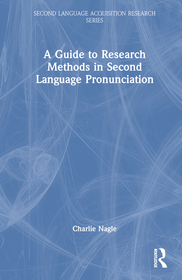
A Guide to Quantitative Research Methods in Second Language Pronunciation
Series: Second Language Acquisition Research Series;
- Publisher's listprice GBP 145.00
-
69 273 Ft (65 975 Ft + 5% VAT)
The price is estimated because at the time of ordering we do not know what conversion rates will apply to HUF / product currency when the book arrives. In case HUF is weaker, the price increases slightly, in case HUF is stronger, the price goes lower slightly.
- Discount 10% (cc. 6 927 Ft off)
- Discounted price 62 346 Ft (59 378 Ft + 5% VAT)
Subcribe now and take benefit of a favourable price.
Subscribe
69 273 Ft

Availability
Estimated delivery time: In stock at the publisher, but not at Prospero's office. Delivery time approx. 3-5 weeks.
Not in stock at Prospero.
Why don't you give exact delivery time?
Delivery time is estimated on our previous experiences. We give estimations only, because we order from outside Hungary, and the delivery time mainly depends on how quickly the publisher supplies the book. Faster or slower deliveries both happen, but we do our best to supply as quickly as possible.
Product details:
- Edition number 1
- Publisher Routledge
- Date of Publication 31 July 2024
- ISBN 9781032245560
- Binding Hardback
- No. of pages278 pages
- Size 229x152 mm
- Weight 453 g
- Language English
- Illustrations 22 Illustrations, black & white; 3 Halftones, black & white; 19 Line drawings, black & white; 54 Tables, black & white 583
Categories
Short description:
This book offers a comprehensive resource on the state-of-the-art in L2 pronunciation, surveying the most up-to-date theoretical and methodological developments to highlight the multidimensional nature of pronunciation scholarship and directions for future research.
MoreLong description:
This book offers a comprehensive resource on the state-of-the-art in L2 pronunciation, surveying the most up-to-date theoretical and methodological developments to highlight the multidimensional nature of pronunciation scholarship and directions for future research. The volume examines both speech perception and production, including the perception-production link. The book explores production from a range of perspectives, including acoustic analysis of specific features and listener-based ratings of global dimensions of pronunciation. Each chapter spotlights a different dimension of pronunciation through a consistent structure, including a summary of the latest research, a critical appraisal of methods, and an overview of data analysis procedures with recommendations for practical implementation. The innovative interconnected structure allows readers to build on their knowledge with each successive chapter while also allowing the flexibility to use chapters as standalone units depending on individual interests. A concluding chapter outlines a research agenda for future scholarship, spotlighting the methods and approaches that are most likely to advance the field. This book is an invaluable resource for graduate students and researchers, at all stages of their careers, looking to expand their knowledge base in SLA and L2 pronunciation and related fields such as phonetics and phonology.
A major contribution to pronunciation research, this engaging volume is packed with clear explanations of key concepts, along with detailed practical advice on the special issues that frequently arise in data collection and analysis. Essential reading for new and seasoned researchers alike.
Murray J. Munro, Professor Emeritus, Simon Fraser University
I cannot praise this book enough. Charlie Nagle’s Guide to Research Methods is a state-of-the-art overview and an engaging primer to research design and data analysis that will inspire both novice and seasoned scholars. Writing with candor, clarity, and flair, Nagle mentors the reader, through personal insight and examples of best research practice, on how to be a conscientious, caring, and creative researcher.
Pavel Trofimovich, Professor, Concordia University (Montreal, Canada)
Charlie Nagle has produced a superb resource, which will be valuable for anyone interested in research methods in SLA, not only pronunciation. The message that ‘absence of evidence is not evidence of absence’ rings true: consequently, choosing the right methods for the research questions posed is essential. The meticulous and accessible nature of the writing and analyses make this an excellent text for applied linguistics programs. In a clear, step-by-step manner, Charlie outlines every stage of the design of experiments, but this is much more than a how-to manual. Drawing on literature from several disciplines within SLA, Charlie has created an informative volume that is likely to be a classic in the years to come.
Tracey Derwing, Professor Emeritus, University of Alberta
A guide to quantitative research methods in second language pronunciation provides 8 accessible chapters that serve as the authoritative introduction to this growing field of research. It provides relevant examples of some of the current analytic techniques used by pronunciation researchers, all of which are described in a clear manner and complimented with R code. Importantly, this definitive guide makes some of the new analytic tools of open science and reproducible research accessible to students and early career researchers and serves as a foundational reference for anybody interested in learning and teaching open science practices in second language pronunciation research.
Joseph Casillas, Associate Professor, Rutgers University
MoreTable of Contents:
Contents
1. Introduction
2. Researching Speech Perception
3. Researching the Production of Specific Features
4. Researching the Perception-Production Link
5. Researching the Production of Global Features
6. Researching Pronunciation Training and Instruction
7. Researching Individual Differences
8. Conclusion
More




